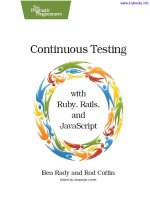offensive security penetration testing with backtrack (lab guide)v3 2
Bạn đang xem bản rút gọn của tài liệu. Xem và tải ngay bản đầy đủ của tài liệu tại đây (10.45 MB, 339 trang )
Offensive Security
Penetration Testing with
BackTrack
PWB Online Lab Guide
v.3.2
2
Table of Contents
Before We Begin 16
i. Legal Stuff 16
ii. Important Notes 16
iii. Labs and IP Address Spaces 16
iv. Control Panel 17
Network Keys / Secrets 17
v. PWB VPN Labs 18
vi. How to Approach This Course 19
vii. Reporting 19
Reporting for PWB 21
Interim Documentation 22
viii. Penetration Testing Methodology 23
1. Module 1: BackTrack Basics 25
1.1 Finding Your Way around BackTrack 26
1.1.1 Exercises 28
1.2 BackTrack Services 29
1.2.1 DHCP 29
1.2.2 Static IP Assignment 30
1.2.3 SSHD 30
1.2.4 Apache 32
1.2.5 FTP 33
OS-7561-PWB
OS-7561-PWB
OS-7561-PWB
OS-7561-PWB
3
1.2.6 TFTPD 34
1.2.7 VNC Server 35
1.2.8 Additional Resources 35
1.2.9 Exercises 36
1.3 The Bash Environment 37
1.3.1 Simple Bash Scripting 37
1.3.2 Sample Exercise 37
1.3.3 Sample Solution 39
1.3.4 Additional Resources 43
1.3.5 Exercises 44
1.4 Netcat the Almighty 45
1.4.1 Connecting to a TCP/UDP Port with Netcat 45
1.4.2 Listening on a TCP/UDP Port with Netcat 48
1.4.3 Transferring Files with Netcat 49
1.4.4 Remote Administration with Netcat 50
1.4.5 Exercises 55
1.5 Using Wireshark 56
1.5.1 Peeking at a Sniffer 56
1.5.2 Capture and Display Filters 59
1.5.3 Following TCP Streams 60
1.5.4 Additional Resources 60
1.5.5 Exercises 61
OS-7561-PWB
OS-7561-PWB
OS-7561-PWB
OS-7561-PWB
4
2. Module 2: Information Gathering Techniques 62
2.1 Open Web Information Gathering 64
2.1.1 Google Hacking 64
2.2. Miscellaneous Web Resources 79
2.2.1 Other Search Engines 79
2.2.2 Netcraft 79
2.2.3 Whois Reconnaissance 81
2.3 Exercises 86
3. Module 3: Open Services Information Gathering 87
3.1 DNS Reconnaissance 87
3.1.1 Interacting with a DNS Server 88
3.1.2 Automating Lookups 90
3.1.3 Forward Lookup Brute Force 91
3.1.4 Reverse Lookup Brute Force 95
3.1.5 DNS Zone Transfers 97
3.1.6 Exercises 103
3.2 SNMP Reconnaissance 104
3.2.1 Enumerating Windows Users 105
3.2.2 Enumerating Running Services 105
3.2.3 Enumerating Open TCP Ports 106
3.2.4 Enumerating Installed Software 107
3.2.5 Exercises 110
OS-7561-PWB
OS-7561-PWB
OS-7561-PWB
OS-7561-PWB
5
3.3 SMTP Reconnaissance 111
3.3.1 Exercises 112
3.4 Microsoft NetBIOS Information Gathering 113
3.4.1 Null Sessions 113
3.4.2 Scanning for the NetBIOS Service 114
3.4.3 Enumerating Username/Password Policies 115
3.4.4 Exercises 119
3.5 Maltego 120
3.5.1 Network Infrastructure 120
3.5.2 Social Infrastructure 121
4. Module 4: Port Scanning 122
4.1 TCP Port Scanning Basics 123
4.2 UDP Port Scanning Basics 125
4.3 Port Scanning Pitfalls 125
4.4 Nmap 125
4.4.1 Network Sweeping 128
4.4.2 OS Fingerprinting 130
4.4.3 Banner Grabbing/Service Enumeration 131
4.4.4 Nmap Scripting Engine 132
4.5 PBNJ 136
4.6 Unicornscan 142
4.7 Exercises 144
OS-7561-PWB
OS-7561-PWB
OS-7561-PWB
OS-7561-PWB
6
5. Module 5: ARP Spoofing 145
5.1 The Theory behind ARP Spoofing 146
5.2 Doing It the Hard Way 146
5.2.1 Victim Packet 148
5.2.2 Gateway Packet 149
5.3 Ettercap 152
5.3.1 DNS Spoofing 153
5.3.2 Fiddling with Traffic 155
5.3.3 SSL Man in the Middle 158
5.3.4 Exercises 159
6. Module 6: Buffer Overflow Exploitation 160
6.1 Looking for Bugs 161
6.2 Fuzzing 161
6.3 Exploiting Windows Buffer Overflows 164
6.3.1 Replicating the Crash 164
6.3.2 Controlling EIP 167
6.3.3 Locating Space for Your Shellcode 171
6.3.4 Redirecting the Execution Flow 173
6.3.5 Finding a Return Address 174
6.3.6 Basic Shellcode Creation 178
6.3.7 Getting the Shell 182
6.3.8 Exercises 186
OS-7561-PWB
OS-7561-PWB
OS-7561-PWB
OS-7561-PWB
7
6.4 Exploiting Linux Buffer Overflows 188
6.4.1 Setting Things Up 188
6.4.2 Controlling EIP 193
6.4.3 Landing the Shell 196
6.4.4 Avoiding ASLR 199
7. Module 7: Working with Exploits 201
7.1 Looking for an Exploit on BackTrack 205
7.2 Looking for Exploits on the Web 209
8. Module 8: Transferring Files 211
8.1 The Non-interactive Shell 212
8.2 Uploading Files 213
8.2.1 Using TFTP 213
8.2.2 Using FTP 215
8.2.3 Inline Transfers 216
8.3 Exercises 218
9. Module 9: Exploit Frameworks 219
9.1 Metasploit 220
9.1.2 Metasploit 3 Command Line Interface (msfcli) 223
9.1.5 Exercises 233
9.2 Interesting Payloads 234
9.2.1 Meterpreter Payload 234
9.2.3 Binary Payloads 240
OS-7561-PWB
OS-7561-PWB
OS-7561-PWB
OS-7561-PWB
8
9.2.3.1 Exercises 241
9.2.4 Additional Framework v3.x Features 242
10. Module 10: Client Side Attacks 244
10.1 Network Implications 245
10.2 CVE-2009-0927 245
10.3 MS07-017: From PoC to Shell 248
10.4 MS06-001: An Example from MSF 254
10.5 Client Side Exploits in Action 256
10.6 Exercises 257
11. Module 11: Port Fun 258
11.1 Port Redirection 259
11.2 SSL Encapsulation: Stunnel 262
11.2.1 Exercises 264
11.3 HTTP CONNECT Tunneling 265
11.4 ProxyTunnel 267
11.5 SSH Tunneling 268
11.6 What about Content Inspection? 271
11.7 Exercise 271
12. Module 12: Password Attacks 272
12.1 Online Password Attacks 273
12.2 Hydra 277
12.2.1 FTP Brute Force 278
OS-7561-PWB
OS-7561-PWB
OS-7561-PWB
OS-7561-PWB
9
12.2.2 POP3 Brute Force 278
12.2.3 SNMP Brute Force 279
12.2.4 Microsoft VPN Brute Force 279
12.2.5 Hydra GTK 280
12.3 Password Profiling 280
12.3.1 CeWL 281
12.4 Offline Password Attacks 282
12.4.1 Windows SAM 282
12.4.2 Windows Hash Dumping: PWDump and FGDump 283
12.4.3 John the Ripper 285
12.4.4 Rainbow Tables 286
12.4.5 “Windows Does WHAT????” 289
12.4.6 Exercises 292
12.5 Physical Access Attacks 293
12.5.1. Resetting Microsoft Windows 293
12.5.2 Resetting a Password on a Domain Controller 296
12.5.3 Resetting Linux Systems 296
12.5.4 Resetting a Cisco Device 297
13. Module 13: Web Application Attack Vectors 298
13.1 Cross Site Scripting 299
13.1.2 Information Gathering 301
13.1.3 Browser Redirection and iframe Injection 303
OS-7561-PWB
OS-7561-PWB
OS-7561-PWB
OS-7561-PWB
10
13.1.4 Stealing Cookies and Abusing Sessions 304
13.2 Local and Remote File Inclusion 306
13.3 SQL Injection in PHP/MySQL 308
13.3.1 Authentication Bypass 309
13.3.2 Enumerating the Database 310
13.3.3 Code Execution 313
13.4 SQL Injection in ASP/MSSQL 315
13.4.1 Identifying SQL Injection Vulnerabilities 318
13.4.2 Enumerating Table Names 319
13.4.3 Enumerating the Column Types 320
13.4.4 Fiddling with the Database 321
13.4.5 Microsoft SQL Stored Procedures 321
13.4.6 Code Execution 323
13.5 Web Proxies 324
13.6 Exercises 326
14. Module 14: Trojan Horses 328
14.1 Binary Trojan Horses 329
14.2 Open Source Trojan Horses 329
14.3 World Domination Trojan Horses 330
15. Module 15: Windows Oddities 331
15.1 Alternate NTFS Data Streams 331
15.2 Registry Backdoors 333
OS-7561-PWB
OS-7561-PWB
OS-7561-PWB
OS-7561-PWB
11
16. Module 16: Rootkits 335
16.1 Aphex Rootkit 336
16.2 Hxdef Rootkit 336
16.3 Exercise R.I.P 336
17. Module 17: Final Challenges 337
OS-7561-PWB
OS-7561-PWB
OS-7561-PWB
OS-7561-PWB
12
All rights reserved to Offensive Security LLC, 2011.
©
No part of this publication, in whole or in part, may be reproduced, copied, transferred or any other
right reserved to its copyright owner, including photocopying and all other copying, any transfer or
transmission using any network or other means of communication, any broadcast for distance
learning, in any form or by any means such as any information storage, transmission, or retrieval
system, without prior written permission from the author.
OS-7561-PWB
OS-7561-PWB
OS-7561-PWB
OS-7561-PWB
13
Penetration Testing with BackTrack
A Note from the Authors
Thank you for opting to take the “Offensive Security—PWB” extended lab training. PWB is not your
usual IT security course. We hope to challenge you, give you a hard time, and make you think
independently during the training. We will often throw you into the deep end with short exercises and
challenges. You won't be served fish; you'll be taught to catch them.
My personal opinion of the IT security arena is that it should be formally separated into two distinct
fields: defensive security and offensive security. This idea came to me when a good friend and
Microsoft networking mentor of mine came to visit me during a course. He and I started talking about
the (latest at the time) ZOTOB worm (MS05-039) and I asked him if he had lately seen any instances of
it. He answered that he saw an infection in one location, where it was overcome quickly. He then said,
“That ZOTOB was annoying though; it kept rebooting the servers until we managed to get rid of it.” At
that point, a massive beam of light shone from the heavens and struck me with full force. More about
this enlightenment later.
I took my friend aside and proceeded to boot a vulnerable class computer and told him, “Watch this.
I'm going to use the same exploit as ZOTOB uses when it spreads”. I browsed to the milw0rm site, and
downloaded the first (at the time) exploit on the list, and saved it to disk. I opened a command
prompt, compiled the exploit using the cl command line Visual Studio compiler, and ran the exploit.
The output looked similar to ms05-039.exe <victim IP>. I punched in the IP address of the vulnerable
computer with one finger and pressed enter. I was immediately presented with a command shell
belonging to the victim machine. I typed in ipconfig and then whoami. I gave him just enough time to
see the output, and then typed exit. Exiting the shell caused svchost.exe to crash, and a reboot
window popped up, just like the ones he saw.
I could slowly see the realization seep in. His face lost color and he slowly sat down on the nearest
chair. He looked at me with horrified eyes, and somehow manage to gasp “how” and “why” at the
OS-7561-PWB
OS-7561-PWB
OS-7561-PWB
OS-7561-PWB
14
same time. He then quickly exited the room and made some urgent phone calls. I was later honored
to have this friend sit in one of my courses, which unfortunately left him extremely paranoid.
Now, back to my enlightenment. I realized that this master of Windows Active Directory and Multiple
Domain PKI Infrastructure guru did not have the same narrow “security” knowledge as a 12-year-old
script monkey. He was not aware of the outcomes of such an attack and did not know that the
“reboot” syndrome he observed was an “unfortunate” byproduct of system access to the machine.
This made me realize that there is a huge gap between the defensive and offensive security fields, a
gap so big that a 12 year old (who probably doesn't know what TCP/IP stands for) could outsmart a
well-seasoned security expert.
Hopefully, if this separation between the defensive and offensive fields is clear enough, network
administrators and (defensive) security experts will start to realize that they are aware of only half of
the equation, and that there's a completely alien force they need to deal with. To truly be able to
defend your assets, you must first understand the attacks and the attackers.
This course attempts to partially fill in this gap and present the penetration testing and ethical hacking
field to the student. This course presents basic attack vectors and introduces the penetration testing
cycle. The course focuses on understanding and then implementing the “why” and the “how,”
respectively. Be aware, however, that this course will not teach you how to be an ethical hacker nor a
penetration tester. These designations are achieved after many years of study and experience. This
course merely introduces the basic tools and techniques used in common attack vectors. Perhaps
most importantly, this course introduces the frame of mind required to become a true security
professional.
<Zen>The nature of this course and related topics is disruptive. Labs might behave oddly; things might
not always work as expected. Be ready to manipulate and adapt as needed, as this is the way of the
pen tester </Zen>.
Saying this, we've taken all possible measures for the labs to be easily understood and in many cases
recreated by the student, using both the course movies and the written lab guide. If a certain topic is
OS-7561-PWB
OS-7561-PWB
OS-7561-PWB
OS-7561-PWB
15
new or alien to you, try sticking to the guide, and things should be OK. Once you feel comfortable with
the topic, you can try experimenting with lab variables.
We have active forums and an IRC channel where you can interact with other students; these
resources will be very valuable to you during the course.
We've added several “Extra Mile” mini challenges to part of the exercises for those wanting to
particularly advance in the field of penetration testing and are willing to put in the extra time and
effort. These challenges are recommended but not necessary.
We really hope you enjoy the course, at least as much as we enjoyed making it, and that you gain new
insights and a deeper understanding into what the security arena looks like from an attacker's
perspective.
Mati Aharoni (muts)
Offensive Security Team
OS-7561-PWB
OS-7561-PWB
OS-7561-PWB
OS-7561-PWB
16
Before We Begin
i. Legal Stuff
The following document contains the lab exercises for the course and should be attempted ONLY
INSIDE THE OFFENSIVE SECURITY SECLUDED LAB. Please note that most of the attacks described in
the lab guide would be considered ILLEGAL if attempted on machines that you do not have explicit
permission to test and attack. Since the lab environment is secluded from the Internet, it is safe to
perform the attacks INSIDE the labs ONLY. We assume no responsibility for any actions performed
OUTSIDE the labs. Please remember this basic guideline: With knowledge comes responsibility.
ii. Important Notes
Please read the Offensive Security Lab Introduction PDF before starting the labs. This will ensure you
enjoy the labs to the fullest, with minimum interferences both to you and other students. Make sure
you read these introductions carefully; they're important.
iii. Labs and IP Address Spaces
Please note that the IP addresses presented in this guide (and videos) do not necessarily reflect the
IP addresses in the Offensive Security labs. Do not try to copy the examples in the lab guide
verbatim; you need to adapt the example to your specific lab configuration.
Depending on your lab assignment, your VPN connection will connect you to the Student Network,
either on the 192.168.10/23, 192.168.12/23 or the 192.168.14/23 ranges. Students are NOT able to
communicate between VPN addresses. Please make sure to read the “Resources and Downloads”
section in our forums as they contain many important links and downloads that you will require for
the course. We also strongly recommend you read the Offsec FAQ BEFORE connecting to the Labs.
OS-7561-PWB
OS-7561-PWB
OS-7561-PWB
OS-7561-PWB
17
iv. Control Panel
Once logged into the VPN labs, you can access your PWB Labs control panel. Through this control
panel you can manage, revert, and reset lab machines and passwords.
The panel can be accessed at https://192.168.10.7, https://192.168.12.7 or https://192.168.14.7
depending on your network. You should accept the invalid SSL certificate.
Network Keys / Secrets
Initially, the panel will allow you (in a limited manner) to revert machines on the Student Network, as
well as your own dedicated XP lab machine. Certain vulnerable servers in the lab will contain a
network-secret.txt file with an MD5 hash in it. These hashes will unlock additional networks in your
control panel.
OS-7561-PWB
OS-7561-PWB
OS-7561-PWB
OS-7561-PWB
18
v. PWB VPN Labs
The following graphic is a simplified diagram of the PWB labs. You initially VPN into the Student
Network and “hack your way” into additional networks as the course progresses. Once you have
completed the course videos, you will have the base skills required to penetrate most of the
vulnerable computers in our labs. Certain machines will require additional research and determination
in order to compromise.
OS-7561-PWB
OS-7561-PWB
OS-7561-PWB
OS-7561-PWB
19
vi. How to Approach This Course
This course throws you into the deep end—very quickly. Because each person learns differently, our
course materials aim to cover visual, oral, verbal, physical, and logical learning styles to enhance your
learning experience. While the videos and PDF lab guide generally coincide with each other,
information may be presented differently between the two.
Our general recommendation is to approach every module by first reading the module in the lab
guide, and then watching the relevant videos.
Once the concept is clear, attempt to recreate the exercise using relevant targets in the labs. Please
note that not all of the topics covered in the lab guide appear in the videos—such as modules 14–16.
Once you complete the videos and lab guide, you will have an opportunity to use the knowledge and
techniques learned in the course to compromise as many machines as possible in the various
networks. The labs are built to challenge both the newcomer and the novice security professional.
vii. Reporting
The most dreaded part of every penetration test, without a doubt, is the final report. The final report
is also the only tangible product the client receives from the engagement—and is of paramount
importance. The report must be presented well, written clearly, and, most importantly, aimed at the
right audience.
I once presented a technical report to the CEO of a large company. The executive summary contained
a screenshot of a remote command prompt of the company's domain controller, with administrative
privileges demonstrated. The CEO was generally unimpressed with the report and asked me, “What
does the black box [the screenshot of the remote shell] prove? What exactly did you do?”
OS-7561-PWB
OS-7561-PWB
OS-7561-PWB
OS-7561-PWB
20
It then struck me that a screenshot of a “remote command prompt” would mean nothing to a non-
technical person. With the CEO’s permission, I proceeded to use my laptop to log on to the domain
with administrative privileges and then changed his password. When I logged into the domain with his
profile and opened up his Outlook, the CEO muttered, “Ooooooh. . . .”
This was a good lesson for me in report targeting—in other words, making sure the target reader
understands the essence of the report.
A good report will usually include an executive overview and a technical summary. The executive
overview summarizes the attacks and indicates their potential business impact, while suggesting
remedies. The technical summary will include a methodological presentation of the technical aspects
of the penetration test, usually read by IT staff and management.
OS-7561-PWB
OS-7561-PWB
OS-7561-PWB
OS-7561-PWB
21
Reporting for PWB
During this course you will be required to log your findings in the Offensive Security VPN labs. Once
you complete the course lab guide and videos, you will be conducting a full-fledged penetration test
inside our VPN labs for the THINC.local domain.
The initial VPN connection will connect you to the Student Labs network where you will encounter
various vulnerable servers that will serve as a practice arena for most of the techniques covered in the
course. As the course progresses you will be encouraged to compromise more and more servers,
eventually spanning to other networks as well.
The final documentation should be submitted in the format of a formal Penetration Test report. It
should include an executive summary and a detailed rundown of all compromised machines (not
including your XP lab machine). A template for this report is attached as both a MS Word and Open
Office document for your convenience.
Students opting for the OSCP certification must include an additional section to this report that deals
with the Certification Challenge (Exam) Labs. This final report should be sent back to our Certification
Board, in PDF format, no more than 24 hours after the completion of the certification exam.
OS-7561-PWB
OS-7561-PWB
OS-7561-PWB
OS-7561-PWB
22
Interim Documentation
To deal with the volume of information gathered during a penetration test, I like to KeepNote (a
multipurpose note-taking application) to initially document all my findings. Using such an application
helps both in organizing the data on paper as well as in my head. When the penetration test is over, I
use the interim documentation to compile the full report.
KeepNote is available in BackTrack as an extra application, and has convenient inbuilt features such as
screen grabbing and HTML export capabilities.
It doesn't really matter which program you use for your interim documentation as long as the output
is clear and easy to read. Get used to documenting your work and findings—it's the only professional
way to get the job done!
OS-7561-PWB
OS-7561-PWB
OS-7561-PWB
OS-7561-PWB
23
viii. Penetration Testing Methodology
This course is very practical and leaves much of the studying to the student. However, I felt the need
to elaborate a bit about the process and methodology of a penetration test as I see it.
A penetration test (pen test) is an ongoing cycle of research and attack against a target or boundary.
The attack should be structured and calculated, and, when possible, verified in a lab before being
implemented on a live target. This is how I visualize the process of a pen test (the following graphic is
a rough model that doesn't include all vectors):
As the model suggests, the more information we gather, the higher the probability of a successful
penetration. Once we penetrate the initial target boundary, we usually start the cycle again—for
example, gathering information about the internal network in order to penetrate it deeper.
Eventually, each security professional develops their own methodology, usually based on their specific
technical strengths. The methodologies suggested in this course are exactly that: suggestions. We
encourage you to check pages such as for additional
OS-7561-PWB
OS-7561-PWB
OS-7561-PWB
OS-7561-PWB
24
methodologies, such as the Open Source Security Testing Methodology (OSSTM) in order to broaden
your point of view.
OS-7561-PWB
OS-7561-PWB
OS-7561-PWB
OS-7561-PWB
25
1. Module 1: BackTrack Basics
Overview
This module prepares the student for the modules to come, which heavily rely on proficiency
with the basic usage of Linux and tools such as the Bash shell, Netcat, and Wireshark.
Module Objectives
At the end of this module, the student should:
1. Be able to comfortably use the BackTrack Linux distribution, including service
management, tool location, and IP address management.
2. Possess basic proficiency with the Linux Bash shell, text manipulation, and Bash shell
scripting.
3. Boast a practical understanding of the various uses of Netcat.
4. Have basic proficiency in the use of the Wireshark network sniffer.
Reporting
Reporting is not mandatory for this module, however you might want to keep note of specific
syntaxes and tricky command line options.









